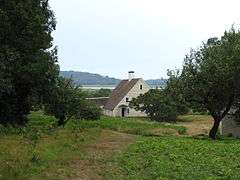Greenwood Farm (Ipswich, Massachusetts)
|
Paine-Dodge House | |
 | |
  | |
| Location | Ipswich, Massachusetts |
|---|---|
| Coordinates | 42°41′36″N 70°49′0″W / 42.69333°N 70.81667°WCoordinates: 42°41′36″N 70°49′0″W / 42.69333°N 70.81667°W |
| Built | 1685 |
| Architect | Unknown |
| Architectural style | Colonial, Other |
| MPS | First Period Buildings of Eastern Massachusetts TR |
| NRHP Reference # | [1] |
| Added to NRHP | March 9, 1990 |
Greenwood Farm is a historic property and nature reserve located in Ipswich, Massachusetts, which is owned by The Trustees of Reservations. It features the Paine (or Paine-Dodge) House, a First Period farmhouse constructed in 1694.
History of Greenwood Farm Reservation
In 1640, Robert Paine arrived in America and received a grant of land along the salt marshes at Jeffrey's Neck, near Ipswich, MA.
In 1642, Richard Smith arrived in America and obtained farm land adjacent to that of Robert Paine. In 1694, Robert Paine had a salt-box style house constructed on his property, not far from the Ipswich River.[2] In 1702, Daniel Smith, grandson of Richard Smith, and son of Richard Smith II married his neighbor, Elizabeth Paine, granddaughter of Robert Paine, and daughter of Robert Paine II. Partly as a dower, and partly in consideration of Daniel's promise to provide lifelong care for Robert Paine II's infirm son (John Paine), Robert deeded the salt-box house and much of the Paine farmland to Daniel Smith, effective in 1703. Ownership of the Paine house thereby passed to the Smith family, and the deeded land expanded the land the Smiths already owned. Elizabeth Paine died in 1717. In 1722 Daniel Smith married Deborah Willcomb. The Smith land and the land and house that had once belonged to the Paines remained in the possession of the Smith/Willcomb descendants for five generations.
Greenwood Farm Reservation is named for Thomas Smith Greenwood, born in 1807 to Ruth Smith and Thomas Greenwood. Ruth Smith died from complications of childbirth, and Thomas Smith Greenwood was left in the care of Smith relatives. As a youth, Thomas Smith Greenwood went to sea, but when he was a young adult he returned to live at the farm (which at that time was known as Hickory Farm or Hickory Grove Farm). Thomas married Paulina Adams Thurlow, and raised their family of seven children in a large house built circa 1828, not far from the 1694 house built by Robert Paine. Greenwood acquired ownership of additional parcels of land, including the area known as Diamond Stage, expanding the farm to well over 300 acres (1.2 km2), but did not inherit legal ownership of the basic farm lands and buildings until 1870, when his uncle Daniel Smith died.
Thomas Smith Greenwood was commissioned to be the first keeper of the lighthouses constructed near Greenwood Farm at Lakeman Beach (now known as Crane Beach). When the ship Deposit went aground on Lakeman ledge in 1839, Thomas Smith Greenwood and Joseph Marshall were instrumental in rescuing several of the passengers. For their heroic actions, each man received a gold medal from the Humane Society of the Commonwealth of Massachusetts.
In 1901, by operation of will, ownership of the Greenwood land passed to Thomas S. Greenwood's daughter Pauline T. Farley, who would be the last of the Smith descendant owners. Pauline held the land until 1911, when she sold it to Guy Murchie, to whom she had previously leased it for several years. The land was acquired by Robert Dodge in 1916, whose daughters turned it over to the care of the Trustees of Reservations in 1975.[2] The Dodge-Paine house was listed on the National Register of Historic Places in 1990.[1]
Other people of interest
Other people of interest who have resided at Grove Farm/Greenwood Farm include:
- Charles Johnson Maynard, naturalist, publisher and illustrator of numerous books on natural history — first husband of Pauline T. Greenwood.
- Helen Stevens Greenwood, a professional [listed] artist and operator of an art school in Boston. Helen was known professionally as Helen S. Farley and then Helen Farley Blaney.
- Henry Robertson Blaney, the second husband of Helen Greenwood—a professional artist and author/illustrator of "Old Boston" and "The Golden Caribbean."
See also
- National Register of Historic Places listings in Ipswich, Massachusetts
- National Register of Historic Places listings in Essex County, Massachusetts
References
- 1 2 National Park Service (2008-04-15). "National Register Information System". National Register of Historic Places. National Park Service.
- 1 2 "Greenwood Farm". The Trustees of Reservations. Retrieved 2014-01-01.
